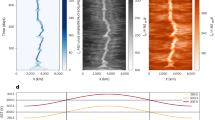Abstract
Aircraft observations and model simulations show that cloud development is strongly modulated by the impact of cloud-aerosol interactions on precipitation forming processes. New insights into the mechanisms by which aerosols dominate the cloud cover of marine shallow clouds suggest that feedbacks between the cloud microstructure and cloud dynamics through precipitation processes play a major role in determining when a solid cloud cover will break up into a field of trade wind cumulus. Cloud-aerosol interactions dominate not only the dynamics of marine shallow clouds, but also the lifetime and the vertical disposition of latent heat of deep convective clouds over ocean and even more strongly over land. Recent coincident satellite measurements of aerosols and cloud properties quantify the aerosol effects on cloud cover and radiative forcing on regional and global scales. The shapes of the satellite retrieved relations between aerosols and cloud properties are consistent with the suggested ways by which aerosols affect clouds via precipitation processes, particularly by affecting the intensity of the cloud vertical air motions and its vertical development.
Similar content being viewed by others
References
Albrecht, B. A.: 1989, ‘Aerosols, cloud microphysics, and fractional cloudiness’, Science 245, 1227–1230.
Andreae, M. O., Rosenfeld, D., Artaxo, P., Costa, A. A., Frank, G. P., Longo, K. M., and Silva-Dias, M. A. F.: 2004, ‘Smoking rain clouds over the Amazon’, Science 303, 1337–1342.
Carslaw, K. S., Harrison, R. G., and Kirkby, J.: 2002, ‘Cosmic rays, clouds, and climate’, Science 298, 1737–1739.
Gerber, H.: 1996, ‘Microphysics of marine stratocumulus clouds with two drizzle modes’, J. Atmos. Sci. 53, 1649–1662.
Grabowski, W. W.: 2003, ‘Impact of Cloud Microphysics on Convective—Radiative Quasi Equilibrium Revealed by Cloud-Resolving Convection Parameterization’, J. Clim. 16, 3463–3475.
IPCC: 2001, ‘Climate change 2001: The scientific basis’, Contribution of Working Group I to the Third Assessment Report of the Intergovernmental Panel on Climate Change, J. T. Houghton, Y. Ding, D. J. Griggs, M. Noguer, P. J. van der Linden, X. Dai, K. Maskell, and C. A. Johnson (eds.), Cambridge University Press, Cambridge, UK, 881 pp.
Khain, A., Rosenfeld, D., and Pokrovsky, A.: 2005, ‘Aerosol impact on the dynamics and microphysics of convective clouds’, Q. J. R. Meteorol. Soc., 131, 1–25..
Kaufman, Y. J., Koren, I., Remer, L. A., Rosenfeld, D., Rudich, Y.: 2005, ‘Smoke, Dust and Pollution Aerosol Clouding the Atlantic Atmosphere’, Proc. Natl. Acad. Sci. USA 102, 11,207–11,212.
Koren, I., Kaufman, Y. J., Rosenfeld, D., Remer, L. A., and Rudich, Y.: 2005, ‘Aerosol invigoration and restructuring of Atlantic convective clouds’, Geophys. Res. Lett. 32, doi:10.1029/2005GL023187.
Ramanathan, V., Crutzen, P. J., Kiehl, J. T., and Rosenfeld, D.: 2001, ‘Aerosols, Climate and the Hydrological Cycle’, Science 294, 2119–2124.
Rosenfeld, D., and Gutman, G.: 1994, ‘Retrieving microphysical properties near the tops of potential rain clouds by multispectral analysis of AVHRR data’, Atmos. Res. 34, 259–283.
Rosenfeld, D., Lahav, R., Khain, A. P., and Pinsky, M.: 2002, ‘The role of sea-spray in cleansing air pollution over ocean via cloud processes’, Science 297, 1667–1670.
Rosenfeld, D., Kaufman, Y. J., and Koren, I.: 2006, ‘Switching cloud cover and dynamical regimes from open to closed Benard cells in response to the suppression of precipitation by aerosols’, Atmos. Chem. Phys. Disc. 6, 2503–2511.
Sekiguchi, M., Nakajima, T., Suzuki, K., et al.: 2003, ‘A study of the direct and indirect effects of aerosols using global satellite data sets of aerosol and cloud parameters’, J. Geophys. Res. 108, doi:10.1029/2002JD003359.
Svensmark, H., and Friis-Christensen, E.: 1997, ‘Variation of cosmic ray flux and global cloud coverage — a missing link in solar-climate relationships’, J. Atmos. Terr. Phys. 59, 1225–1232.
Twomey, S. A.: 1977, ‘The influence of pollution on the shortwave albedo of clouds’, J. Atmos. Sci. 34, 1149–1152.
Williams, E., Rosenfeld, D., Madden, M., et al.: 2002, ‘Contrasting convective regimes over the Amazon: Implications for cloud electrification’, J. Geophys. Res. 107, doi:10.1029/2001JD000380.
Wood, R., and Hartmann, D. L.: 2006, ‘Spatial variability of liquid water path in marine low cloud: The importance of mesoscale cellular convection’, J. Clim. 19, 1748–1764.
Author information
Authors and Affiliations
Corresponding author
Rights and permissions
About this article
Cite this article
Rosenfeld, D. Aerosol-Cloud Interactions Control of Earth Radiation and Latent Heat Release Budgets. Space Sci Rev 125, 149–157 (2006). https://doi.org/10.1007/s11214-006-9053-6
Received:
Accepted:
Published:
Issue Date:
DOI: https://doi.org/10.1007/s11214-006-9053-6




